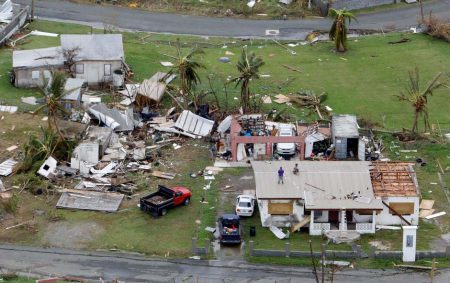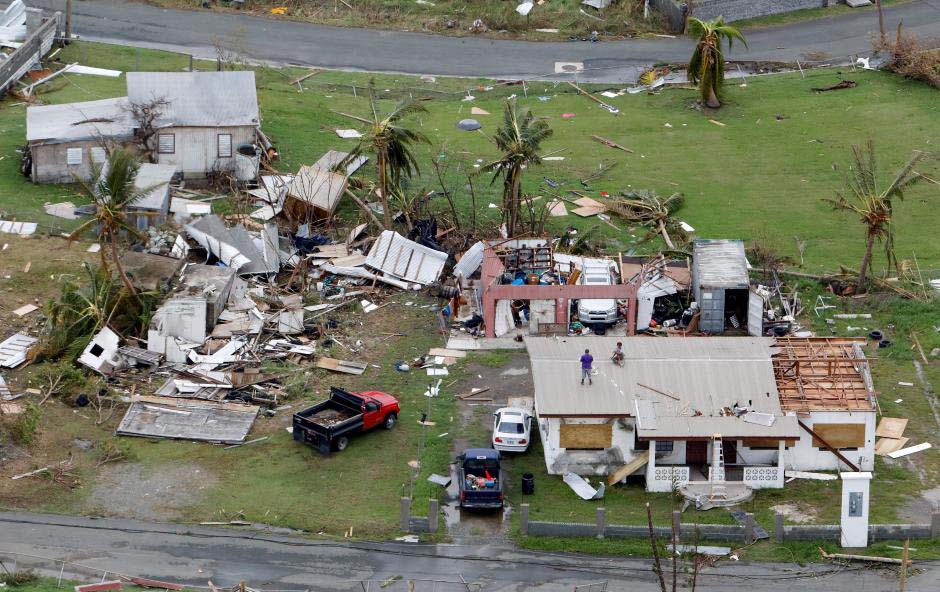
SAN JUAN, Puerto Rico, (Reuters) – Hurricane Maria churned toward the Turks and Caicos today after lashing Puerto Rico and other Caribbean islands with winds and rain that destroyed homes, flooded streets, crippled economies and left at least 32 people dead.
Maria is the second major hurricane to hit the Caribbean this month and the strongest storm to hit the U.S. territory of Puerto Rico in nearly 90 years. It knocked out the island’s power and several rivers hit record flood levels.
At least 15 people were killed in Puerto Rico, El Nuevo Día newspaper reported. Puerto Rico Governor Ricardo Rossello told cable TV news channel CNN he had reports of at least 13 people on the island being killed.
“We have a lot of flooding,” he said in the interview, adding there “was a major disaster here in Puerto Rico.”
Fourteen deaths were reported on the island nation of Dominica, which has a population of about 71,000. Two others were killed in the French territory of Guadeloupe and one on the U.S. Virgin Islands.
The death toll in the Caribbean is likely to rise when searches resume at daybreak.
Rossello imposed a dusk-to-dawn curfew through Saturday for the island’s 3.4 million people. He said about 700 people have been rescued from floodwaters and communication was difficult with the southeastern part of the island.
Among those killed in Puerto Rico were eight people who drowned in Toa Baja, about 20 miles (32 km) west of San Juan, Mayor Bernardo Márquez told the newspaper.
Three elderly sisters were killed by a mudslide on Wednesday in the mountainous central municipality of Utuado, El Nuevo Día said, citing relatives and the mayor of Utuado.
In the heart of the island’s capital San Juan, which has a fort and buildings from the Spanish colonial era, the storm left a trail of wreckage. Toppled trees cut power lines and streets were turned into rivers.
U.S. President Donald Trump told reporters the island had been “totally obliterated” and he planned to visit.
Puerto Rico was already facing the largest municipal debt crisis in U.S. history.
A team of judges overseeing its bankruptcy has advised involved parties to put legal proceedings on hold indefinitely as the island recovers, said a source familiar with the proceedings.
Maria is a Category 3 hurricane on the five-step Saffir-Simpson scale, with sustained winds of up to 125 mph (205 kph). It was 35 miles (55 km) east-northeast of Grand Turk Island as of 5 a.m. EDT (0900 GMT), the U.S. National Hurricane Center said.
It was forecast to bring storm surges of up to 12 feet (3.7 m) to the southeastern Bahamas as well as the Turks and Caicos, it said, adding that a gradual weakening was forecast for the next 48 hours as it heads north in the Atlantic Ocean.
Maria was expected to bring as much as 40 inches (102 cm) of rain to Puerto Rico and an island-wide flash flood watch was in effect. Between eight and 16 inches (20 to 40 cm) of rain was expected on Turks and Caicos, which could cause flash floods and mudslides, the National Hurricane Center said.
Maria looked unlikely to hit the continental United States but its storm swells will reach the southeastern coast from Friday, the NHC said.
“These swells are likely to cause dangerous surf and life-threatening rip currents along the coast for the next several days,” it said.
Utility crews from the U.S. mainland headed to Puerto Rico to help restore the power grid and the U.S. military sent ground forces and aircraft to assist with search and rescue.
More than 95 percent of wireless cell sites were not working on Thursday afternoon on the island, the U.S. Federal Communications Commission said. In the U.S. Virgin Islands, more than three-quarters of cell sites are out of service.
LONG ROAD TO RECOVERY
In Dominica, Maria damaged about 95 percent of roofs, the U.N. Office for the Coordination of Humanitarian Affairs said. It struck as a Category 5 storm on Monday, ripping foliage off plants and obliterating the island’s vital agricultural sector.
The storm caused flooding in the Dominican Republic when it passed nearby from Wednesday night.
Maria passed close by the U.S. Virgin Island of St. Croix, home to about 55,000 people, early on Wednesday as a Category 5 storm, knocking out electricity and most mobile phone service.
“The worst is behind us,” Virgin Islands Governor Kenneth Mapp told reporters on Thursday. The government has imposed a 24-hour curfew until further notice.
About 600 people throughout the U.S. Virgin Islands are in emergency shelters and many parts are without power, Mapp said.
“It’s going to be a long road to recovery,” Mapp said. Maria hit about two weeks after Hurricane Irma pounded two other U.S. Virgin Islands: St. Thomas and St. John.
Irma, one of the most powerful Atlantic storms on record, killed at least 84 people in the Caribbean and the United States. It followed Harvey, which killed more than 80 people when it hit Texas in late August and caused flooding in Houston.
More than two months remain in the Atlantic hurricane season, which runs from June 1 to Nov. 30.

